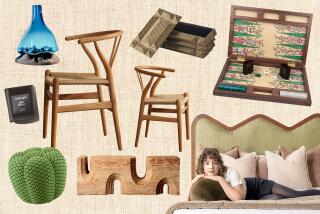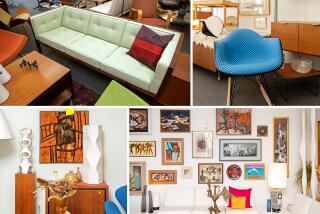Porches and Their Furniture Have Evolved
- Share via
In the early 1900s, most homes were built with a large porch that faced the street. People sat on the porch and watched traffic or commiserated with neighbors.
Porch furniture was usually made of wicker. Some had flowered, upholstered cushions. The wicker easily adapted to wet conditions. Pieces made of bamboo were also used.
Upholstered furniture was not practical because it could become wet in the rain.
In the 18th century, a porch often faced woods or a lake, It was a cool, quiet place to sit. In the days before wicker furniture was made, wooden chairs and settees that were suitable for indoors as well as outdoors were kept on the porch. George Washington had Windsor chairs on his porch at Mt. Vernon.
Today, furniture made of weatherproof plastic is popular for the garden or porch. There are even cushions made of fabrics that shed water.
*
Question: I have several flower-printed tablecloths of my mother’s. Can I use them and wash them without doing any damage? I would like to collect them, What types are best?
*
Answer: Tablecloths printed with bright flowers or figures were popular in the 1940s and ‘50s. Most were made of cotton or linen that was easily washed, but all required ironing, The colors will fade if tablecloths are washed repeatedly,
The most popular cloths are those sold as souvenirs that picture a map of places such as Florida, California or Texas.
Theme tablecloths also are popular, and collectors search for those picturing food, Mexican scenes, sea-related objects or farm scenes. Unused cloths can still be found.
Faded cloths sell for less than $20. Crisp examples can bring up to $200. Most tablecloths are either 40 by 40 inches or 52 by 52 inches, made for use on a kitchen table.
*
Q: I bought a heavy, mechanical baby doll at an auction. The large doll lies in a wooden basket. Her arms and legs move in the air, and her head moves up, down and to one side. There is a paper sign attached to the front of the basket that reads, “My First Sweetheart.” Can you tell me anything about the doll?
*
A: Your large doll was used as an advertising display for Sweetheart soap bars. The brand, made by the Manhattan Soap Co,, was advertised as “the soap that agrees with your skin.”
The electrically powered doll was made by Mechanical Man Inc. of New York. It was marketed to retailers that sold the soap. It was probably made during the 1930s, when Sweetheart soap sponsored several popular radio shows. Your display doll is valued at more than $400.
*
Q: I just got my father’s old lava lamp, Does it require special care to keep it working?
*
A: The lava lamp was introduced in the United States in 1965. It was more a novelty than a lamp. A slowly oozing, colored liquid changed shape when the heat of the lamp made a glob of wax inside rise and fall.
Don’t light your lamp for more than eight hours -- the wax will create a ball. Don’t shake the lamp -- it will make the water cloudy, Don’t ever open the lamp. And keep it away from children and pets -- it gets hot.
*
Q: How old is the paper clip? I have been saving all sorts of strange-looking ones from my dad’s office. Maybe it’s the start of a collection.
*
A: The paper clip called the Gem was invented in 1900. It looked very much like the paper clips we use today. It was a single piece of wire bent into an almost oval shape.
The clips were sold in a black box labeled “Cushman & Dennison.” There have been many “improvements.” Clips can be shaped like an X, a rectangle with an X at one end, or even a circle. But the basic design is still the most popular.
Before the paper clip, office. clerks would fold a corner of the paper, rip the center of the fold, then fold half again to keep the pages together. Other clerks used straight pins to hold papers- You can probably find hundreds of different types of paper clips.
*
Q: My old caster set looks like a silver chariot with wheels. A cupid forms the center handle. Sitting in the chariot are two glass cruets for oil and vinegar, a sugar shaker and a small jar. The mark on the bottoms reads, “Simpson Hall Miller & Co. Treble Plate.” Can you tell me anything about the age and maker?
*
A: Simpson Hall Miller 84 Co. was founded in Wallingford, Conn., in 1866. Samuel Simpson, who was already well-known as a maker of Britannia ware, started the new company to do silver plating.
The words “Treble Plate” indicate your caster set is silver-plated. Dinner casters were popular during the Victorian era, Most of the fancy ones were first made in the 1870s. If you have all the original bottles and their stoppers, your set is worth about $700.
For a listing of helpful books and publications, include a self-addressed, stamped (55 cents) envelope to Kovels, Los Angeles Times, King Features Syndicate, 235 E. 45th St., New York, NY 10017.
*
Current Prices
Current prices are recorded from antiques shows, flea markets, sales and auctions throughout the United States. Prices vary because of local economic conditions.
* Photograph of passengers on Pacific Electric Railroad, Mt. Lowe, Calif., 1910, 6 1/2 inches, $25.
* “Peanuts” lunch box, metal, Snoopy and gang under tree, Linus band, King ‘Seeley Thermos, 1973, $50.
* Silver Lami Beauty Queen swimsuit, “Sea Twist,” one-piece, diamond cutout midriff, pointed bodice line-twisted into crisscross, size 8, labeled “DeWeese ‘Design.” original paper tags, $70.
“My Favorite Martian” board game, Bill Bixby and Ray Walston on box, 1963, Transogram, $90,
* 7-Up door push, aluminum, yellow ground, black lettering, 1940s, 8 1/2 by 8 3/4 inches, $165.
* Clarice Cliff bowl, Autumn Crocus, flared, yellow band on inside rim, blue, orange and purple flowers, 5 inches, $345.
* Raggedy Ann & Andy beanbag dolls. 1971, Knickerbocker, 10 inches, pair, $415.
* Wemyss pottery pig, seated, black spots, pink nose, eyes, ears and tail, Scotland, circa 1900, 2 1/4 Inches, $500,
* Val St. Lambert cameo glass-covered box, faceted knob applied to cylindrical covered glass box, lavender and etched flowering wisteria, 1920, 3 by 6 inches, $865.
* American Chippendale mahogany wing chair, upholstered, arched crest, square scribed legs, tilted rear legs, circa 1770, 46 inches, $3,600.
More to Read
Sign up for Essential California
The most important California stories and recommendations in your inbox every morning.
You may occasionally receive promotional content from the Los Angeles Times.










